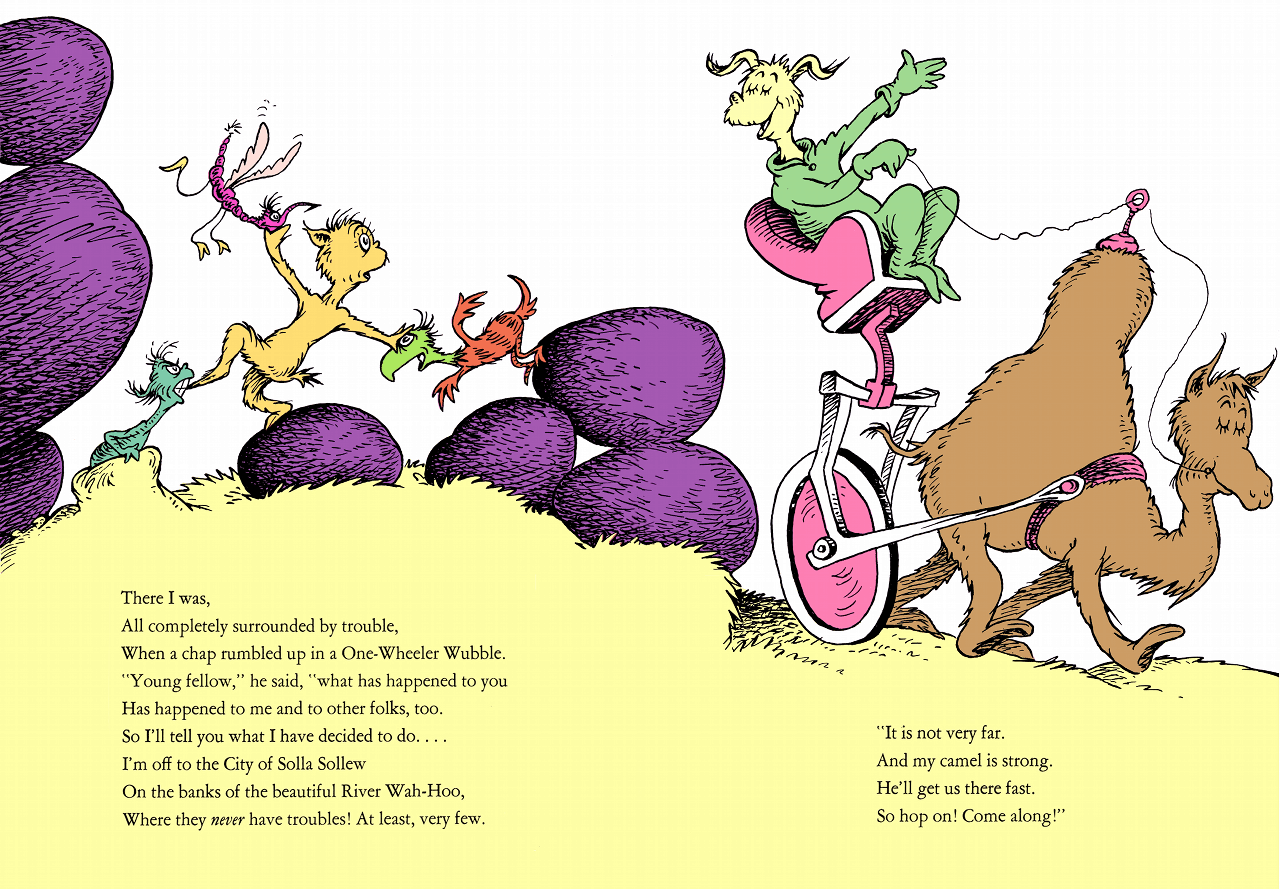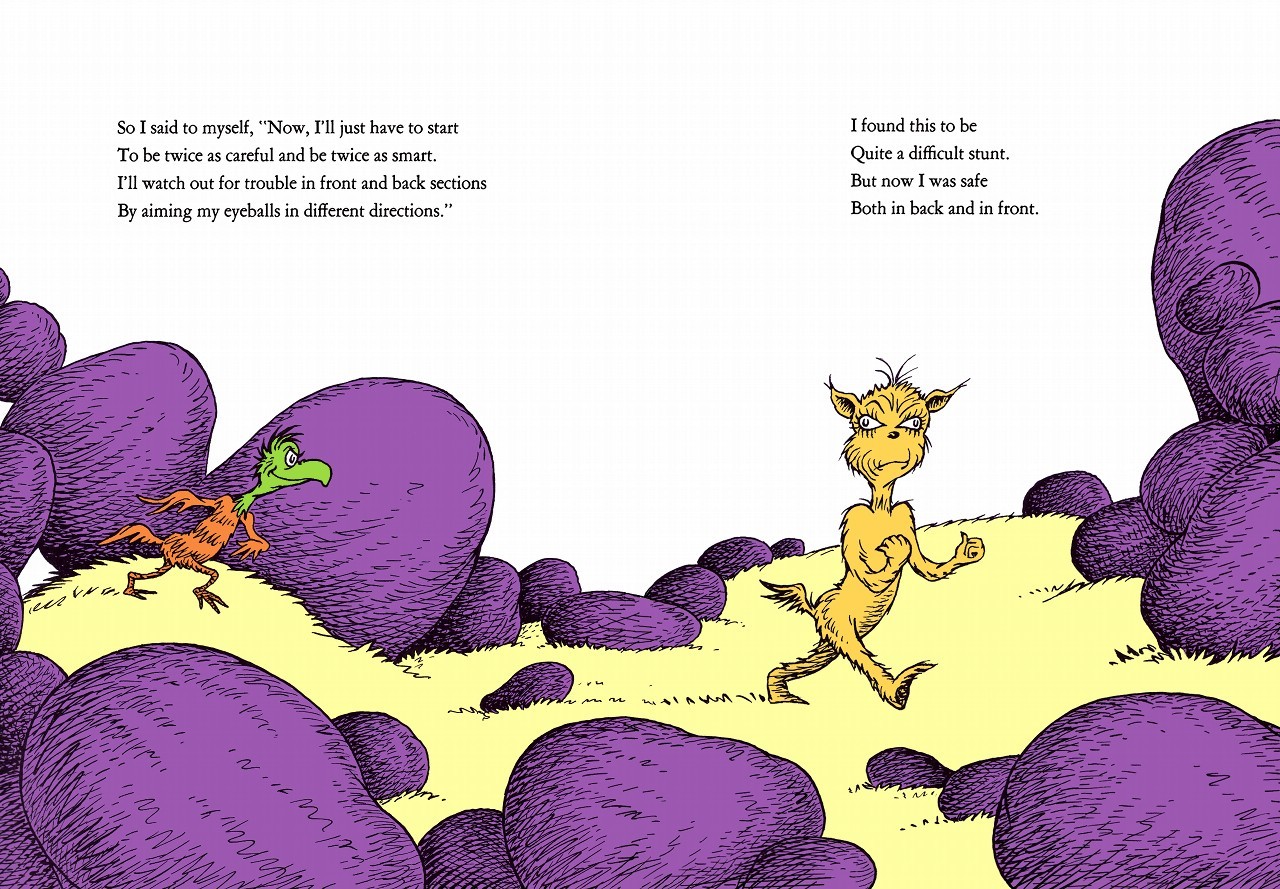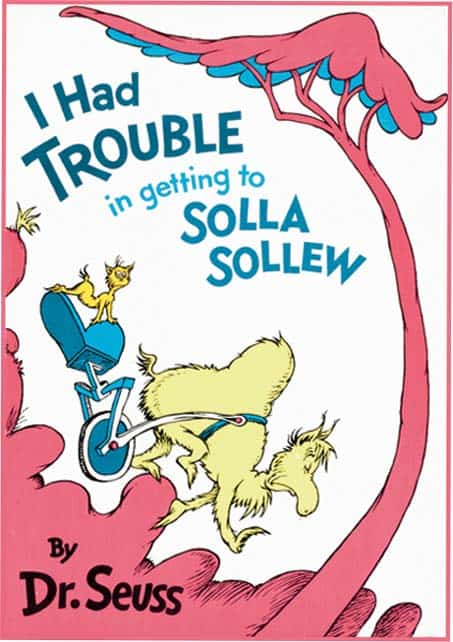This month I’m blogging a series aimed at teaching kids how to structure a story. This seven-step structure works for all forms of narrative. It works for picture books, songs, commercials, films and novels. Today I take a close look at I Had Trouble In Getting To Solla Sollew by Dr Seuss.
Solla Sollew is plotted using classic mythic structure. A character goes on a journey, changes a little along the way, meets a variety of friends and foes (and some who are both), ends up in a big big struggle and then either returns home or finds a new one. Yesterday I looked closely at The Gruffalo, which is also mythic structure but less obviously so. The day before I looked closely at The Gingerbread Man, which is pretty classic mythic structure except Gingerbread Man never meets any helpers along the way (and spoiler alert, he doesn’t live to learn anything from his journey). I figure it’s time to present a solid, classical mythic structure picture book with all of the most basic elements.
STORY STRUCTURE OF I HAD TROUBLE IN GETTING TO SOLLA SOLLEW
WHO IS THE MAIN CHARACTER?
Our first person narrator is also the main character, because he’s telling a story about his own journey. This is an old creature looking back on a time when he was young. We know this from the first sentence, ‘I was once carefree and happy and young’. That makes the little brown guy an extradiegetic narrator. He’s ‘outside the universe’ of the story, because he’s looking back on a time long since passed. (‘Extra’ means ‘outside’.)
What even is that creature? Dr Seuss’s creatures are deliberately ambiguous, part human, part animal. Why so many animals in picture books? Well, there are a bunch of reasons.
What’s wrong with Little Brown Guy?
Main characters have something wrong with them which the author shows right at the start. (Perfect characters have no growing to do, which means no character arc and no story.)
Brown Guy is dissatisfied with his lot. This is understandable in a way. I felt sorry for him when his backside suffers not one but two injuries. The bigger problem is his ‘grass is greener on the other side’ attitude. He thinks Solla Sollew is going to be sooo much better than his home.
WHAT DOES THE LITTLE BROWN GUY WANT?
He wants to get away from the annoyances of his home, specifically the Quilligan Quail, the Skritz and the Skrink. He has heard there’s a place where there are very few troubles. That place is known as Solla Sollew.
OPPONENT/MONSTER/BADDIE/ENEMY/FRENEMY

Brown guy meets a variety of characters along his journey:
- The One-Wheeler Wubble: At first he seems to be a friend, but he turns out to be a bit of a frenemy when he persuades Brown Guy to do all the work of pulling himself and his camel along.
- Dr Sam Snell: Tries to be genuinely helpful by telling Brown Guy about the bus, but the bus has had four punctures and isn’t coming.
- Horace P. Sweet: The manager of the bus company isn’t in the story, but because his note advises walking, he’s a foe.
- The Midwinter Jicker: Dr Seuss doesn’t tell the reader what’s so bad about the Midwinter Jicker, but we’re told he ‘came early this year’ (like cold and flu season), and that ‘it’s not going to be very comfortable around here’. This is a great example of an author withholding information to create brief intrigue. You don’t need to tell the reader absolutely everything.
- The family of owls and mice: An unlikely, and therefore funny, combo. (Owls eat mice, don’t they?) This is where Brown Guy takes refuge for the night in bad weather, but Brown guy finds it difficult to get any sleep with them around. (The next morning the mice do get eaten and there happens to be a flood, foreshadowing the Brown Guys’ big struggle to come.)
- General Genghis Khan Schmitz: At first he seems like a friend, coming to Brown Guy’s rescue, but it turns out the General wants to use Brown Guy as a foot soldier in a big struggle, furnishing him with only one bean as bullet. This makes him most definitely a foe.
Note that the big struggles escalate in intensity, and that Brown Guy meets a variety of outright enemies versus helpers (who are sometimes helpful but there’s always a catch). This is what classic mythic structure looks like.
WHAT’S THE PLAN?
In a mythic structure plot, the plan is ‘Go from point A to point B for some specific purpose’.
But even before he leaves, he’s come up with a plan which doesn’t work:

It’s very common in stories for characters to change their original plans. This picture book is longer than most modern ones, which tend to clock in about 300-400 words. In those newer, shorter picture books there is often no time to change plans, but Solla Sollew is 2,130 words. (And was published in 1965, for the record.)
BIG STRUGGLE
The big struggle in this story is a literal big struggle, which is what makes it classic mythic structure.
He narrowly escapes down a hole.
WHAT DOES THE CHARACTER LEARN?
When he gets to Solla Sollew he learns that this is not a magical, mythical place with very few problems — it’s a massive problem just getting in the door!
He changes plans at this point. He hears about a place with NO problems. He is tempted to go with the fed-up doorman to Boola Boo Ball. But this is the part where we see he has learnt his lesson: He knows from experience that Boola Boo Ball won’t be all it’s cracked up to be. So he decides to return home — better the devil you know.
HOW WILL LIFE BE DIFFERENT FROM NOW ON?
He’s now got a club to fight off those annoying creatures at home. This is symbolic: Rather than running from his problems he’ll stay and fight them, because no matter where he went, he would always have problems to deal with.

